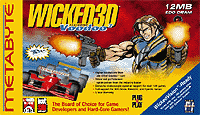
Inofficial metabyte Wicked3D page

Inofficial metabyte Wicked3D page
Quick info: Wicked3D is the best thing ever happened to consumer stereoscopy. Metabyte's brilliant driver software for 3Dfx-Voodoo2, 3Dfx-Banshee and soon other chipsets, brings Stereo3D to almost all software-titles which make use of the common 3D-API's: Direct3D, 3Dfx-Glide and miniOpenGL. They added so many features and gave the user so much control over the process that many software titles easily beat out almost any native Stereo3D game of the past. They provide real Stereo3D, not Pseudo3D! Some games show errors and/or very weak 3D effects though! Anyway, after so many no-brainer 3D-products, finally here is a mega-brainer.
The (H3D-) glasses offered by Metabyte still annoy me, due to their small and dark LCD-panels, but for non-professional users there is no substitute yet. The upcoming ELSA Revelator will change this however.This page concentrates on the gfx-boards and drivers. For details on the glasses please check the unofficial H3D page.
Page released on April 25, 1999
Last update:
Test System 2 x Wicked3D Voodoo2 12 MB
Diamond Monster II 12 MB
Diamond Monster II 8 MB
Wicked3D drivers 2.81 and 3.15 beta
eyeSCREAM drivers
classic H3D Eyewear
eyeSCREAM eyewear
StereoGraphics CrystalEyes2 w. EPC2 sync-doubler
3DTV Corp Model MCS-04 sync-doublerASUS P2B BX-mobo
Celeron 300A o/c to 450 MHz
Windows 98
|
Yes, the renderer has access to the depth information over the 3D raw-data submitted to the 3D-API. Therefore the Wicked3D driver 'knows' the distance of each object.
|
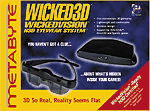
metabyte Wickedvision - glasses
The Wicked3D Wickedvision H3D Eyewear System is just a plain H3D-system in metabyte packaging. To get some fun out of it you'll need a Wicked3D board or a 3rd party Voodoo2 board plus the Wicked3D eyeSCREAM stand-alone driver-CD.
I think the plain Wickedvision package without the drivers is outdated by now, but it still rests on some store shelves, especially outside the USA.
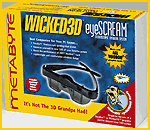
metabyte eyeSCREAM - glasses plus driver-CD
The Wicked3D eyeSCREAM package is the right choice for anybody who already owns a 3rd party Voodoo2 board. It contains the H3D eyewear system and the driver-CD, which provides universal stereoscopic support. If we take the existence of Brightland H3D viewer shareware and the new H3D Activator freeware into account which gives finally some backward compatibility to the H3D system we have nothing less than the most interesting consumer shutterglasses package ever. - If only those LCD-panels weren't so small.
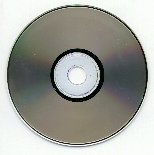
metabyte eyeSCREAM driver CD - sold seperately
For customers who already own the H3D-glasses and a 3rd party Voodoo2 board Metabyte offers the eyeSCREAM drivers seperately for $29. Unfortunately this offer is only available in North-America.

metabyte Voodoo 2 board
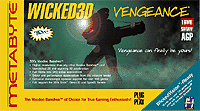
metabyte 3Dfx Banshee board
The Wicked3D graphics boards with the much needed driver-CDs. The right choice for H3D owners.
Will also work for owners of 3rd party non-proprietary sync-doubler controlled shutterglasses and of course for the famous homebrew sync-doubler.
Compatibility Chart O.K.: compatible
- : incompatible
card - glasses
compatibilityclassic H3D/
old Wickedvision package w/o CDeyeSCREAM ELSA Revelator 3rd party
sync-doubler with manual control 4)homebrew
sync-doublerWicked3D Voodoo2 O.K. O.K. - O.K. O.K. Wicked3D Banshee O.K. O.K. - O.K. O.K. Wicked3D TNT O.K. O.K. - O.K. O.K. 3rd party Voodoo2 1) O.K. - 1) 1) 3rd party Banshee 2) 2) - 2) 2) 3rd party TNT 2) 2) - 2) 2) STB Voodoo3 - - - - - ELSA Banshee 2), 3) 2), 3) O.K. - O.K. ELSA TNT 1/2 2), 3) 2), 3) O.K. - O.K. ELSA Savage4 3) 3) O.K. - O.K. (ELSA Voodoo3 ????) 3) 3) (O.K.) - (O.K.) 1) eyeSCREAM CD required which is currently only available through mail-order within North-America
2) Wicked3D-stereo may work with upcoming version of the eyeSCREAM drivers; original eyeSCREAM CD required
3) ELSA-stereo drivers may work in conjunction with H3D-Activator (tricky)
4) e.g. StereoGraphics CrystalEyes2 with EPC2 controller; NuVision GX60 with PC-controller, 3DTV/Neotek sync-doubler with manual control
|
There's nothing special about the hardware.
The boards are just plain Voodoo2 and Banshee boards with no extras and no software bundle whatsoever.
The glasses are just plain H3D Eyewear systems.
All the special features are in the driver software!
The biggest flaw of the hardware are the panels of the glasses, which are too small. For a closer look on the glasses check the H3D-page.Since the Wicked3D boards deliver stereo in standard above-below splitscreen format the H3D/eyeSCREAM glasses can be replaced by another sync-doubler glasses system, like the CrystalEyes CE2 with EPC2 controller.
|
The driver CD installs like a charm and after that 3Dfx gaming will never be the same. The Wicked3D drivers gives you control over every aspect of the 3D-hardware up to the point where reality vanishes and make room for miracles.The eyeSCREAM drivers allow to combine two Voodoo2 from different manufacturers and with different amount of memory. Funny: The dashboard in NFS III requires a 12 MB Voodoo2. What happens if you combine an 8 and a 12 MB board in SLI mode under Wicked3D? You see a transparent interlaced dashboard since one board shows it the other not. Wicked3D did a great job in avoiding incompatibilities and crashes in such irregular situations.
|
Every aspect of the drivers can be tested within the setup. Changes in resolution and refresh take effect immediately. I was really happy to see an 'eye test' which determines your ability to see stereo3D at all. You are asked to see a doctor if you can't see the effect.
|
The driver lets you create your own resolution pixel by pixel and your own refresh rate Hz by Hz. While normal Voodoo2 drivers stop at 800x600 with Z-buffer the Wicked3D drivers go up to 1024x692 or 1024x1024 in SLI.
While other drivers start at 60 Hz refresh and stop by 120 Hz, Wicked3D covers 50 Hz to 160 Hz. This is important for users with older monitors. With the extra low 50 Hz refresh some users will be able to use the H3D controller in sync-doubler mode for the first time.
The system never has to be restarted, all changes take effect immediately.
|
This is the most stunning feature of the drivers apart from the stereo3D functions. You can not only define your custom resolutions, you can force virtually any game into this resolution. This way older Glide-titles from the Voodoo-1 era which seemed to be stuck at 640x480 forever now work in 1024x692 on a Voodoo2 or 1024x1024 on a Voodoo2-SLI configuration. This is especially important for stereo-applications since the vertical resolution is cut into half here.
Need for Speed 2 SE which only supported 640x480 in the past is a nice example. Now it flies at 1024x672/1024x1024, the right stuff for resolution junkies.
|
The compatibility is better than anyone could have expected. Most programs do work with resolution override and stereo3D, even older, patched Windows titles, like P.O.D.
DOS-Glide titles do not work with the special features!
Glide and OpenGL
Some programs show a great stereo effect by default, but it is always better to use the stereo.cfg files for Glide and GL titles which come with the driver package. Driver 3.15 beta comes with about 70 config files. Here is the list by Metabyte.
Direct3D
In 3Dfx-Glide and OpenGL programs a warning-screen shows up on activation of the stereo-mode if no stereo.cfg file is found. This screen can be overridden of course.
In Direct3D titles there is no warning. Direct3D titles usually show no graphics errors, but the stereo-effect is often poor or even zero. I don't know if Direct3D titles can be affected by stereo.cfg files. There is a misterious, undocumented tomb_rdr-stereo.cfg file and a config for Forsaken. I believe this titles only exist in a D3D version. The config files for these two titles are very short and I don't think they do much.
In the Wicked3D software list of December Turok-D3D received a gold rating, although the effect with the newest driver (2.81) was zero. A month later Wicked3D released driver 3.15 beta which made Turok-D3D look much better, without any stereo.cfg or other changes in the setup.
Strength of Stereo Effect
A real stereo effect can be seen if the parallax of near and far objects is different. With the Wicked3D hot-keys it's possible to make the parallax very large, but if all objects have the same or almost the same parallax the effect will only be Pseudo-3D. The image will appear to be inside the monitor, but will remain flat in itself.
2D-elements
Surprisingly in many programs the 2D-elements, like car-dashboards, cockpits, on-screen-texts appear to be right. The Wicked3D hotkeys allow to position the image horizontally and vertically. The dashboard in NFS III, the cockpit and HUD in Longbow2, the menus in Tomb Raider 2 and 3, everything's fine!
In fact many programs beat the native stereo-stuff of the past in this respect.
|
The target in ego shooters always posed a problem in stereo3D programs, like H3D-Quake. Metabyte solved this more elegantly than anyone could have expected. They replace the fixed target-sight of such shooters, with their own 'Laser-Pointer'. This Laser targeting system works exactly like a laser-pointer in the real world. It projects a red dot on your target. The dot grows bigger if the object is nearer. It jumps around the room like a real laser dot and you can see and feel the actual distance in stereo-mode. It's much better than any target sight integrated into a game ever. Shame on the game-programers, who haven't invented this by themselves.
The fact that this laser-sight can be applied to any Glide and OpenGL game is another miracle. Don't forget to switch it off before you enter your Formula One car or there will be a laser dot chasing you down the street.
|
In Stereo3D mode the vertical resolution is cut into half per eye. For example in 800x600 mode each eye sees just 300 lines. This leaves unattractive black interlace lines on the screen. An old trick to avoid this is to just double the lines for each image of a stereo pair. Each line is sent twice to the monitor. This doesn't enhance the actual resolution, but avoids the black interlace lines. Usually the images look better that way.
There are two drawbacks: The workload for the monitor and the H3D-controller doubles! Ghosting may be increased!
800x600 in 120 Hz stereo mode looks to the monitor like a 800x300@120 Hz signal,
800x600@120 Hz line-doubled looks like a 800x600@120Hz signal.
800x600 line-doubled with the H3D-controller shut-off looks like 800x1200@60Hz to the monitor.
I tried 1024x692 line doubled, but either the H3D-controller or the monitor refused to work.
|
Board |
|
Split-screen image |
|
H3D-controller |
|
Flipping image |
|
|
|
|
|
|
|
|
|
|
|
|
gfx-board generates a standard signal showing an above-below split-screen stereo3D image |
|
800x600@60Hz |
|
Sync-doubler mode of H3D controller modifies the signal |
|
800x300@120Hz |
|
The glasses are synchronized to the flipping image |
More details and everything about 3D-image-formats right here.
|
|
Wicked3D keeps a game list with ratings on their website. They award gold, silver, bronze and 'not applicable' ratings. Their main focus seems to be on compatibility and graphics errors rather than on the quality and strength of the Stereo3D-effect.
Usually Glide and OpenGL titles with stereo.cfg-file provided by Wicked3D work and look good.
Direct3D titles and Glide/GL titles without stereo.cfg file are a game of chance.The following chart shows my first impression on the Stereo3D-effect, based on the 2.81 driver. It's just a quick shot, not a scientific truth and it's mainly based on my experiences back in January '99!
What you can see from the chart is that many programs which gained a silver or gold rating by Wicked3D appeared to have a weak or very weak stereo effect. I'm shure the problems with Glide and OpenGL programs can be solved with stereo.cfg files.
| Title | API | stereo.cfg | Stereo Effect | Wicked3D's
own rating |
| Bleifuß2/Screamer2 (DOS-Glide!, troublemaker on the V2) | DOS-Glide | - | - | |
| Collin McRae Rally demo | D3D? | - | somewhat weak | gold |
| Crazy Marbles demo | Glide | - | good | silver |
| Descent2 Glide (DOS-Glide, works on the Voodoo2 with a certain patch, but no stereo support) | DOS-Glide | - | - | |
| Descent3 demo, Glide | Glide | - | weak | silver |
| Formula One 2 by Ubi-Soft demo (a must-see) | Glide | - | good | |
| Forsaken rolling demo | D3D? | - | good | |
| Incoming demo | D3D | - | very weak | gold |
| King's Quest 8 demo | Glide | X | good | silver |
| Klingon Honor Guard demo | Glide | X | good | gold |
| Longbow2 demo (crash) | D3D | - | - | |
| Longbow2 demo (the 3D-cockpit is a must-see) | Glide | X | good | silver |
| Moto Racer 2 demo | D3D | - | weak | silver |
| N.I.C.E. 2 demo | D3D? | - | weak | silver |
| Nascar Revolution (eagerly awaiting stereo.cfg file) | Glide? | - | average | (silver, D3D) |
| Need for Speed III full | Glide | X | good | gold |
| Need for Speed IISE full | Glide | X | good | gold |
| P.O.D. | Glide | X | good | gold |
| Plane Crazy demo | Glide | - | weak | gold |
| Quake2 | GL | X | good | gold |
| Star Wars Rogue Squadron demo | D3D | weak | ||
| Star Wars Rogue Squadron demo | Glide | X | good | gold |
| Terra Incognita demo | Glide | - | good | silver |
| Tomb Raider 1 full (DOS-Glide!, troublemaker on V2) | DOS-Glide | - | - | |
| Tomb Raider 2 full | D3D | - | good | gold |
| Tomb Raider 3 demo (a must-see) | D3D | - | good | gold |
| Tonic Trouble demo | Glide | - | weak | |
| Turok demo, D3D, driver 2.81 | D3D | - | very weak | |
| Turok demo, D3D, driver 3.15beta | D3D | - | average | |
| Turok demo, Glide (buggy) | Glide | - | - | |
| Virtua Squad 2 demo | D3D? | - | weak | silver |
| Whiplash 3Dfx (DOS-Glide!, doesn't work on V2 at all) | DOS-Glide | - | - |
|
To put it mildly the Wicked3D drivers will kill the urge of most users for native Stereo3D titles and it will of course finally kill the last ounce of motivation in software developers to provide native support. BTW, it should be a shock for a programmer to suddenly see his own, old program in super-hi-res and stereo3D without touching the original code.
The only thing we can hope for is that they become aware of this technology and do proper 3D-math in their programs. Need for Speed II is a good example. Everything is O.K. from the Stereo3D point of view, except for the horizon. The horizon is a 2D-bitmap and it has the wrong depth information on some tracks. Mathematically the horizon is in front of most other objects. The programmers used some dirty trick to always overwrite the horizon with other objects. This doesn't hurt anybody as long as the game is watched in 2D, but in Stereo3D the horizon sticks out, which looks really really strange. Let's hope the programmers start to take such things into account and do proper 3D-math. This should also help to avoid other non-stereo related slipups in games.
I couldn't find any severe drawbacks in driver level stereo Quake2 compared to native H3D-Quake2. I know some of you won't agree. The Wicked3D programmers avoided out-of-the-screen effects. Some users are disappointed by this, but it avoids eye-strain and unwanted slip-ups. Out-of-screen effects require a reversed parallaxe which puts some pressure on our visual system and if an out-of-screen object touches the border of the screen the illusion of depth is destroyed. There is some out-of-screen effect on the Wicked3D stereo test screen though. In Tomb Raider 3 Lara's hair-tail comes out of the screen while she looks into the sky.
Oh boy, we're almost in heaven. What we need now is a cheap ( < $500), hi-res (1024x768) HMD with headtracking.
Brand and product names are trademarks or registered trademarks of their respective holders.
The author can not guarantee the accuracy of the information given on this page.
Christoph Bungert, Germany